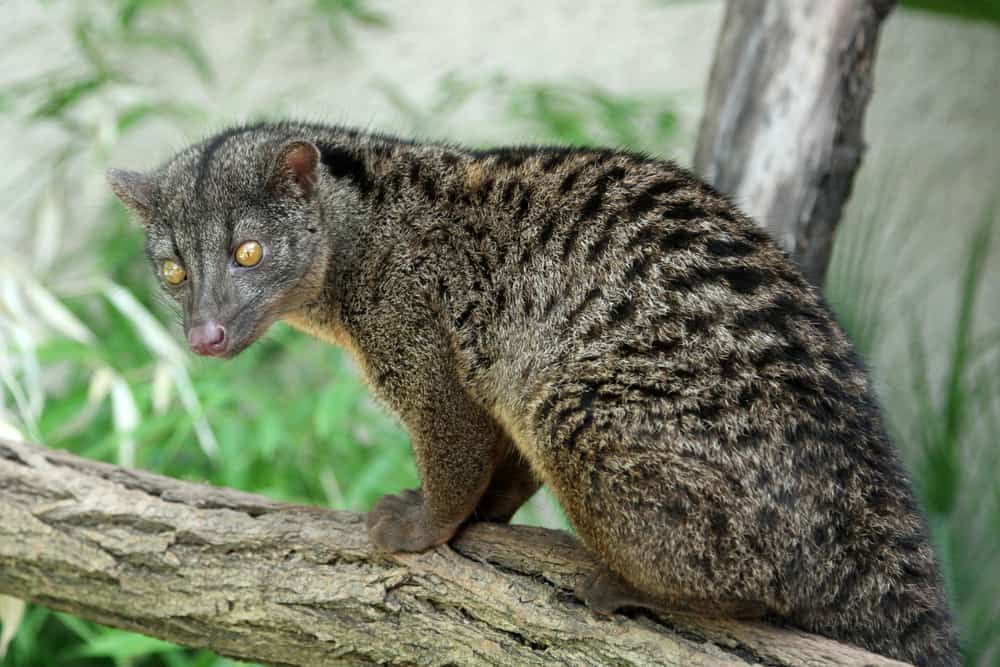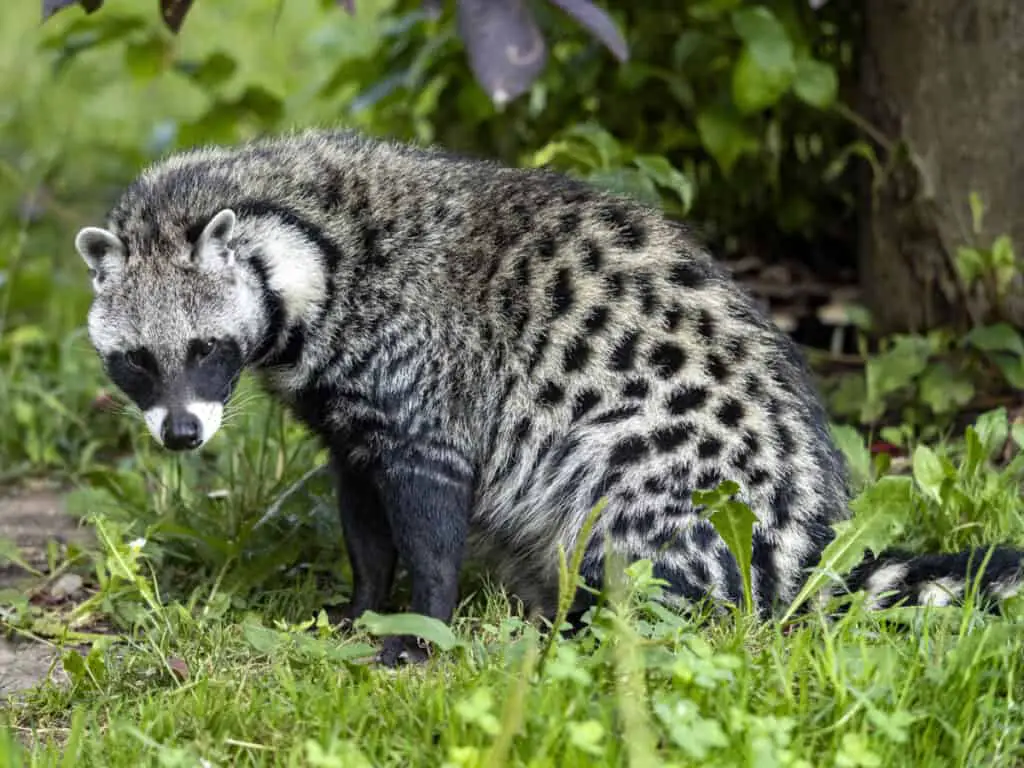The African palm civet forms the Genus Nandinia, is a small mammal that belongs to the family of Viverridae. It is native to Africa and primarily inhabits tropical forests across West and Central Africa. The species has been categorized as Least Concern on the IUCN Red List due to its stable population size and wide distribution range.
The African palm civet is an arboreal creature with sharp claws adapted for climbing trees. Its fur ranges from reddish-brown to grayish-brown with dark spots or stripes along its body. They are nocturnal animals and mainly feed on fruits, insects, rodents, birds, and reptiles while spending most of their daytime hours in tree hollows or dense vegetation.
Despite being found in different regions across Africa, there is limited scientific information available regarding this elusive species making it difficult to assess their exact population numbers and conservation status accurately.

Taxonomy And Classification
Nandinia is a genus of the family Nandiniidae and consists of a single species, the African palm civet (Nandinia binotata).
This mammal is native to equatorial Africa, where it inhabits dense rainforests and feeds on fruits, insects, small mammals, and birds.
The African palm civet has been classified in different families throughout history due to its unique morphological characteristics. However, recent molecular studies have confirmed that this species belongs to its own distinct family within the order Carnivora.
Evolutionary history suggests that the African palm civet diverged from other civet species approximately 25 million years ago. This divergence resulted in distinctive physiological adaptations such as elongated snouts and specialized teeth for consuming fruits.
Although they share some common traits with other viverrids like genets and banded mongooses, genetic analyses indicate limited relationships between these groups.
Overall, understanding the evolutionary relationship of Nandinia emphasizes the importance of conserving this enigmatic species through habitat protection and ecological management strategies.
The African Palm Civet’s Predators: Unmasking the Threats
Habitat And Distribution
After exploring the intricate details of taxonomy and classification, it’s time to move on to a topic that is equally fascinating – habitat and distribution.
It’s ironic how despite being called an African palm civet, this species isn’t restricted to Africa alone. The genus Nandinia has a much wider range than what its name suggests.
The African palm civet can be found in various regions across Asia and Africa, including Madagascar, India, Thailand, Vietnam, China, and Malaysia. Its wide-ranging distribution allows it to occupy diverse habitats ranging from dense forests to savannas.
This omnivorous mammal plays an important role in maintaining ecological balance by consuming fruits and insects while also serving as prey for larger predators like leopards and pythons.
Understanding the African palm civet’s ecological niche holds the key to conserving this enigmatic species for future generations.
Maintaining healthy populations of these elusive creatures will require both studying their behavior within different ecosystems they inhabit and protecting them from human activities such as deforestation and poaching.
By doing so we can ensure that these remarkable animals continue to thrive in their natural environment without having any negative impact on our planet’s biodiversity.
Physical Characteristics And Adaptations
The African palm civet (Nandinia) is a medium-sized mammal that measures up to 60 cm in length, with a tail of approximately the same length. The species has distinctive coloration variation, ranging from greyish-brown to reddish-brown on its dorsal side and whitish-grey or yellow-white on its ventral side.
The fur is short and thick, providing insulation against cold temperatures during winter months. Overall, the Nandinia’s physical characteristics make it well adapted to life in the dense forest understory where it spends most of its time.
In terms of locomotion techniques, the African palm civet moves slowly through trees using both quadrupedal and bipedal postures. Its long prehensile tail acts as an additional limb for balance and support while climbing trees. Additionally, this animal can also move quickly along horizontal branches by jumping between them.
On the ground, Nandinia uses an ambling gait when moving about searching for food or water sources at night. These various modes of transportation are essential adaptations for survival within their habitat, allowing them to navigate easily through dense vegetation while avoiding predators such as snakes or birds of prey.

Feeding Habits And Behavior
The African palm civet’s foraging behavior is primarily nocturnal, as they are solitary animals that prefer to hunt under the cover of darkness.
They have a broad range of dietary preferences, which includes fruits, small mammals, birds, insects, lizards, and even carrion.
Their diets vary seasonally depending on food availability in their habitat.
In some areas where there are human settlements nearby, these animals may also consume crops such as bananas and papayas.
Nandinia spp. use their sharp claws to climb trees and search for prey or rip open fruit with their powerful jaws.
This species has been known to store food items in tree hollows for later consumption when food becomes scarce during the dry months.
The African palm civet is considered an important seed disperser due to its role in distributing seeds throughout the forest floor after consuming fruits from various plant species.
Understanding this animal’s feeding habits can help conservationists better protect them by creating suitable habitats that provide adequate sources of nutrition year-round without relying on human-provided resources.
Therefore it is imperative that we continue studying this elusive creature’s behavior patterns so that we can develop effective conservation strategies to ensure its long-term survival in the wild.
Conservation Status And Threats
Conservation Status and Threats:
The African palm civet is classified as a species of least concern on the IUCN Red List. However, little is known about its population size or trends in the wild.
The primary threat to Nandinia comes from habitat loss due to deforestation for agricultural purposes, logging, and human settlement. In addition, they are hunted for their meat and fur in some parts of Africa.
To mitigate these threats, several strategies have been suggested.
Habitat conservation programs should be implemented to protect remaining forested areas where African palm civets live.
Additionally, community involvement can play an essential role in protecting this species by promoting sustainable land use practices that avoid destroying critical habitats.
Finally, hunting regulations must be enforced and penalties imposed on those who violate them to ensure that populations do not decline further due to overhunting.
These measures will help conserve the species and preserve its ecological role in the forests of Africa.
Future Research And Implications
Further research on the African palm civet (genus nandinia) is needed to better understand its ecology and conservation status.
One potential avenue for future study involves investigating the role of this species in seed dispersal within its range. As frugivores, African palm civets consume a variety of fruits and play an important role in maintaining plant diversity through their seed dispersal activities. By studying the feeding habits of these animals and tracking the seeds they disperse, researchers can gain insight into how changes in habitat or population size might impact local ecosystems.
Additionally, technological advancements offer exciting opportunities for further exploration of African palm civet behavior and biology. For example, GPS tracking devices can be used to monitor movement patterns and habitat use, while genetic analysis techniques may help shed light on population structure and connectivity across different regions.
Such advances could provide valuable information that would aid in developing effective management strategies for conserving this species in the wild. Overall, continued research on the African palm civet has the potential to inform broader conservation efforts aimed at preserving biodiversity within tropical forest ecosystems.
Conclusion
Genus Nandinia, commonly known as the African palm civet, is a fascinating species that has captured the attention of many wildlife biologists and conservationists alike. Its unique physical characteristics and behavioral adaptations have allowed it to survive in its natural habitat despite facing numerous threats.
The classification of this species within the family Nandiniidae remains controversial due to limited research on its genetics. However, recent studies indicate that Genus Nandinia is closer related to felids than to other viverrid species.
The African palm civet can be found throughout sub-Saharan Africa, inhabiting dense forests and savannas where it feeds on fruit, insects, small mammals and birds.
Despite being classified as Least Concern by the IUCN Red List, there are still concerns regarding their conservation status due to habitat loss caused by deforestation and human activities such as hunting for bushmeat.
Future research should focus on understanding the genetic makeup of this elusive species and identifying ways in which we can protect their populations from further decline.
In conclusion, studying the genus Nandinia provides us with an opportunity to understand how animals adapt to challenging environments in order to survive. As wildlife biologists and conservationists work towards protecting these magnificent creatures from further harm, let us appreciate their beauty and importance in our ecosystem. By doing so, we not only ensure their survival but also contribute towards maintaining ecological balance for future generations.

